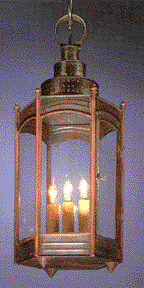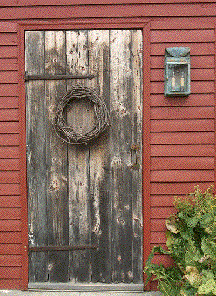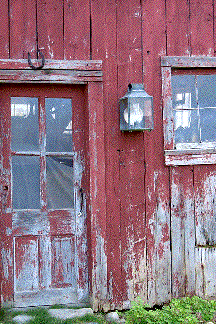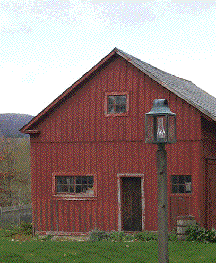Lanterns
|
 Period Lighting's lantern
collection represents a rich assortment of
some of the finest examples of
authenticated reproductions of 18th and
19th century lighting. To our knowledge,
no other maker has ever succeeded in
making so many line-for-line historic
reproductions available to the purchaser
of lighting from this period. Period Lighting's lantern
collection represents a rich assortment of
some of the finest examples of
authenticated reproductions of 18th and
19th century lighting. To our knowledge,
no other maker has ever succeeded in
making so many line-for-line historic
reproductions available to the purchaser
of lighting from this period.
|
|
|
 Inside the home, the soft glow from
lanterns mounted on the walls or suspended from
ceilings imparts a feeling of warmth and elegance,
providing an alternative to more conventional forms
of lighting. A lantern's light will emphasize the
architectural features of your home. Inside the home, the soft glow from
lanterns mounted on the walls or suspended from
ceilings imparts a feeling of warmth and elegance,
providing an alternative to more conventional forms
of lighting. A lantern's light will emphasize the
architectural features of your home.
|

|

|
 As you walk toward the entrance of the
house, wall mounted lanterns can share the task of
lighting the area. Two lanterns with low wattage
will minimize glare more than a single lantern with
large wattage. Since lanterns provide directional
light, their careful placement is important. The
front door, which is the focal point of your home,
is the only area for which we recommend mounting
two fixtures on either side of the upper one-third
of the door providing there is room. As you walk toward the entrance of the
house, wall mounted lanterns can share the task of
lighting the area. Two lanterns with low wattage
will minimize glare more than a single lantern with
large wattage. Since lanterns provide directional
light, their careful placement is important. The
front door, which is the focal point of your home,
is the only area for which we recommend mounting
two fixtures on either side of the upper one-third
of the door providing there is room.
|
|
 The tops of wall lanterns should be
mounted no higher than the top of the door or no
lower than 12" below the top of the door. Wall
lanterns should be mounted securely on a smooth
wooden plate set into the siding rather than
directly on uneven clapboards or shingles. Ambient
light is soft and undefined. It is diffused with
the use of low wattage bulbs (25-75 watts). Glare
is also reduced by placing the fixture higher or
lower than eye level. The tops of wall lanterns should be
mounted no higher than the top of the door or no
lower than 12" below the top of the door. Wall
lanterns should be mounted securely on a smooth
wooden plate set into the siding rather than
directly on uneven clapboards or shingles. Ambient
light is soft and undefined. It is diffused with
the use of low wattage bulbs (25-75 watts). Glare
is also reduced by placing the fixture higher or
lower than eye level.
|

|

|
 As a rule of thumb, post lanterns will
appear about half their actual size when viewed
from 50' away at 7' elevation. When in doubt about
the appropriate size, select a larger model. It is
important to mount a post lantern at least 7-8'
above grade. In northern climates, place the post
at least 3' into the ground to assure that frost
heaves will not disturb the installation. We
believe that a post light is best located at the
entrance to a driveway. It becomes a landmark for
guest, and its scale will not compete with the
features of your house. 100 to 125' intervals
between post lights is recommended for long
driveways. As a rule of thumb, post lanterns will
appear about half their actual size when viewed
from 50' away at 7' elevation. When in doubt about
the appropriate size, select a larger model. It is
important to mount a post lantern at least 7-8'
above grade. In northern climates, place the post
at least 3' into the ground to assure that frost
heaves will not disturb the installation. We
believe that a post light is best located at the
entrance to a driveway. It becomes a landmark for
guest, and its scale will not compete with the
features of your house. 100 to 125' intervals
between post lights is recommended for long
driveways.
|



